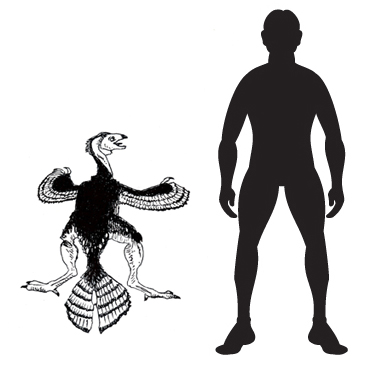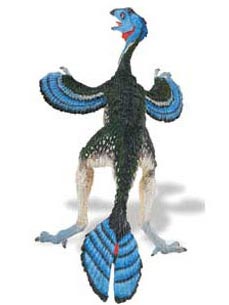The Curious Case of Caudipteryx
The Curious Case of Caudipteryx – Where does it Fit In?
Caudipteryx was a very peculiar looking dinosaur. It is known from several skeletons all found in ancient sediments laid down close to an ancient lake in the Chinese province of Liaoning in north-eastern China. These fine-grained, layered siltstones are famous due to their remarkable preservation qualities that has enabled primitive birds and small dinosaurs to be preserved as fossils with exceptional details. Since the first feathered dinosaurs were discovered in the area scientists from the Institute of Vertebrate Palaeontology and Palaeoanthropology in Beijing have been working closely with palaeontologists from the USA, Canada and Europe. A lot of research is being carried out on the new discoveries and many more amazing finds will come out of the fossil rich sediments in and around the quarries at Sihetun.
A Scale Drawing of Caudipteryx (Caudipteryx zoui)

Picture credit: Everything Dinosaur
Fossils of Caudipteryx
The first fossils of Caudipteryx were found in 1997 and the animal was formerly named and described by a joint North American and Chinese team in 1998. Two species are now known, the first species named and described was Caudipteryx zoui. This little dinosaur grew no bigger than the size of a peacock (estimated length up to 100 centimetres). Caudipteryx was very light, with delicate bones that resembled those of a modern bird. It even had a highly developed wishbone, (furcula) just like modern birds. Scientists estimate that it weighed about 8 kilos, about half the weight of a Velociraptor.
Caudipteryx had long legs, short arms covered in long feathers forming a wing-like structure and long-tail feathers. It is from the ornate tail that this dinosaur gets its name as this dinosaur’s name means “tail feather”. Close analysis of the structure of the feathers indicate that they were symmetrical, these means that they were not designed for flight. The long feathers on the arms and tail could well have been used for display. Dark bands in the fossilised feathers indicate that they were probably brightly coloured, reinforcing the theory that these feathers were used by these little dinosaurs for display.
The colouration of Caudipteryx can only be speculated. It was covered in small, downy proto-feathers, probably for insulation. Fossils of Caudipteryx are one of the few dinosaur fossils that show the impression of feathers. The tail feathers are particularly long, with quills in excess of 15 centimetres long.
A Model of Caudipteryx – Carnegie Collection Caudipteryx

Picture credit: Everything Dinosaur
To view models of feathered dinosaurs and other prehistoric animals: Dinosaur and Prehistoric Animal Models.
A Fast Runner
Scientists are not sure how Caudipteryx lived. Its long shin bones and proportionately smaller thigh bones (femurs), indicate that this dinosaur was probably a fast runner indicating a cursorial (running) lifestyle. However, some palaeontologists believe that as the fossils of Caudipteryx were found in association with lake sediments, this little dinosaur may have waded in the shallows catching small fish, amphibians and insects like a modern wading bird. The toes on the feet seem to be quite well spaced apart, perhaps an adaptation for walking around on mud and other soft ground.
Recent research on the feet of Caudipteryx has led some scientists to conclude that this little, light dinosaur was capable of perching, just like garden birds. As for Caudipteryx’s diet, scientists remain divided as to whether this dinosaur was an active hunter, an omnivore or a plant-eater. Its large eyes, the sharp teeth in the upper jaw and its long legs indicate a hunting lifestyle, but gastroliths associated with this dinosaur may indicate that this animal also ate plants. The gastroliths (stones swallowed by birds and dinosaurs and retained in the gizzard used to grind up food), has led some scientists to deduce that this animal was a herbivore.
Caudipteryx is certainly a curious little dinosaur.
A Drawing of the Feathered Dinosaur Caudipteryx
Picture credit: Everything Dinosaur
The Caudipteryx model featured in this article was part of the model series introduced by Safari Ltd, to view this range of replicas: Safari Ltd. Prehistoric Animal Models.


